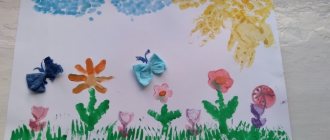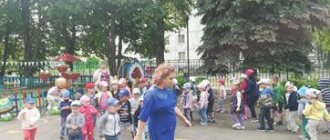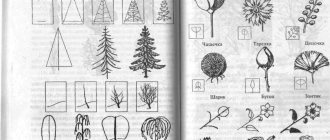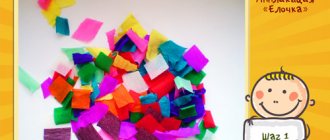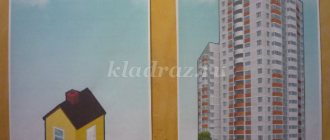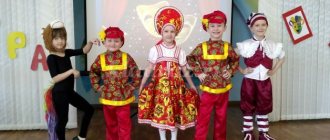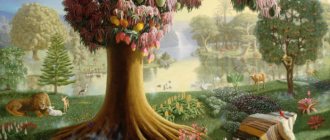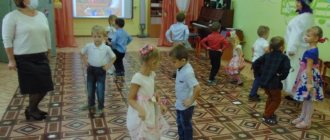On the topic: methodological developments, presentations and notes
Experience of working with children of senior and preparatory school groups on the topic “Native Country” (2003-2004).
Planning on the topic » My city. Native country" Educators Tsyganova T.I. Plaksa T.N.
Creation of a system of work on patriotic education through familiarization with the native country.
Preparatory group for school.
The material provides an example of long-term planning for the topics “Family”, “Kindergarten”, “self-image”, “Native country”.
Expand ideas about Russia - as the country in which we live.
Source
Progress of the lesson:
Children enter the hall to the song “Russia”
, sounding in the record, and stand up, forming a semicircle.
Educator: Guys, finish the sentence in rhyme
I hear the lark's songs
I hear the trill of a nightingale -
This is the Russian side
(This is my homeland)
We live in a huge, beautiful country . This is our big Motherland. Look at the map and mark the territory of Russia. See how big it is. I suggest you take a trip around Russia on a magic carpet. Do you agree?
Educator: We will have stops during the trip. Take your knowledge with you and go ahead! Let's go! (envelopes hang on the map, children take the envelope each time and read the names of the stations).
1 station “Istoricheskaya”
1 slide with images of Russian holidays, dishes that were prepared in ancient Rus', bast shoes, matryoshka dolls, Russian crafts.
— What holidays have been celebrated in Rus' since ancient times? (Christmas, Easter, Maslenitsa.)
.
— What dishes of Russian cuisine do you know? (porridge, pies, pancakes, cabbage soup.)
.
— What kind of shoes did Russian peasants wear? (bast shoes)
.
— What souvenir was considered a symbol of Russia? (matryoshka)
.
— What trades and crafts exist in Russia? (Zhostovo trays, Gzhel, Khokhloma, Dymkovo toy, embossing)
.
Well done! Now let's play the game " Folk Crafts "
(Place handicrafts on the table , place the names of folk handicrafts . Children must read and guess which item the inscription refers to.)
Great, we completed the task, and now back to the magic carpet and to the new station.
2 station "Lesnaya"
2 slide with images of trees, birds, berries, fish, animals and flowers.
Game "Magic Cube"
— I have a cube with pictures on it. I will throw a cube to you, and what picture comes up, you must tell about it.
3 station "Book lovers"
3 slide with images of Russian writers and poets, Russian folk tales .
-Name the great Russian writers and poets. (Pushkin, Tolstoy, Yesenin.)
.
— Name Russian folk tales . ( "Turnip"
,
“Kolobok”
,
“Masha and the Bear”
.).
— Continue Russian folk proverbs :
Bread. (head of everything)
.
It's warm in the sun. (good with mother)
. Forest - wealth and beauty:.
(take care of your forests)
.
The tree is expensive for its fruits, huh. (man of affairs)
.
Live life... (not cross the field)
.
Once I lied... (and became a liar forever)
.
Life is given... (for good deeds)
.
4 station "Znaykina"
.
4 slide with images of the president, the capital of our homeland, the Kremlin, coat of arms, flag.
— Name the capital of Russia. (Moscow)
.
— What is the place of work of the President of Russia? (Moscow Kremlin)
.
— What is the name of the President of Russia? (Putin V.V.)
.
— What are the main symbols of our country ? (Coat of arms, flag, anthem)
.
Now listen to the quatrain:
Where does the Motherland begin?
From the treasured bench at the gate,
From that very birch tree in the field,
Bowing in the wind, it grows.
What Russian person doesn’t love the beautiful birch tree! Birch is a symbol of Russia. How beautiful it is at different times of the year! Straight, slender, white-trunked. Let's start a round dance "Birch"
.
Summary of a drawing lesson on the topic: Motherland. Preparatory group
Goal : to educate children with moral and patriotic feelings for the region where they live, for their small homeland. Objectives: Educational:
- to consolidate the pupils’ ideas about their native land, about the big and small homeland, that for every person the small homeland is the place where he was born, where he lives;
- develop the ability to construct sentences correctly, pay attention to the use of pronouns: mine, mine, ours; — teach children to convey the characteristic features of nature in drawings, reflect their impressions, and consolidate compositional skills. Developmental:
- develop a sense of responsibility and pride for the achievements of the country, native land; - develop aesthetic and emotional feelings when perceiving artistic words, phonetic perception, logical thinking, imagination, memory, speech with movement; - develop speech as a means of communication, the ability to maintain a casual conversation, answering the teacher’s questions; activate and enrich vocabulary on the topic, introduce the words “small Motherland”, “big Motherland”, names of cities into the passive dictionary; -to develop students’ attention, imagination, and horizons.
Educational:
— to cultivate patriotic feelings, love for the Motherland, for the region, for nature;
a feeling of kindness, belonging and empathy for everything living and beautiful that surrounds us through a friendly attitude towards peers, a willingness to communicate. Integration of educational areas: cognitive development, socio-communicative development, speech development, physical development, artistic and aesthetic development. Types of activities : gaming, communicative, cognitive-research, motor, artistic and aesthetic; use of the game situation throughout the entire joint activity. Vocabulary work: Donbass, Donetsk People's Republic, symbols, minerals Individual work: Helping students who have difficulty choosing and describing the sign of a mineral, clarifying and formulating an answer to the question posed. Methods and techniques: visual, verbal, game, reflection, encouragement, logical reasoning, vocabulary activation, question-answer, conversation. Venue: group room. Preliminary work: - conversations: “Our Motherland Donetsk Region”, “Symbols of the Donetsk People’s Republic and the city of Donetsk”; - reading fiction (A. A. Mytarev, L. M. Savelyeva “Our Native Land”, poems about Donbass, Donetsk); - examining illustrations, maps, learning poems about their native land, didactic games, puzzles, excursions; - creation of educational activities in the group - a game situation, group work, conversation, story, reading poems. - dynamic exercises - speech with movement. -listening to music. Technical means: Music center.
2. Donetsk residents can cope with any task. Our Donetsk coal is famous everywhere. You give me strength and inspiration. So may your blossoms be more magnificent!
Source
MAGAZINE Preschooler.RF
OPEN CLASS on familiarization with the surrounding world and drawing in the preparatory group Topic: “Landscape in Russian painting”Goal and program objectives:
Educational:
- continue to introduce children to works of art (painting)
- learn to look at a landscape picture.
Educational:
- To promote the development of monologue speech in children, to develop imagination, thinking, and a sense of composition.
- Continue to develop the ability to understand and appreciate works of art.
- Contribute to enriching the vocabulary: collection, gallery, sketch, landscape painter, reproduction.
Educators:
- To develop the ability to correctly perceive and feel the mood reflected by the artist in the landscape.
- To cultivate a love for one’s native land and nature through works of art.
- To develop the ability to see beauty in the world around us.
Equipment:
- Reproductions and photographs of paintings by landscape artists, portraits of I. Levitan, I. Shishkin, photographs of the Museum of Fine Arts. A.S. Pushkin, Tretyakov Gallery.
Introductory part.
- Hello guys. We have an unusual activity today. I look forward to your active work. We will talk to you about fine art, namely painting. There are three genres of painting: portrait, still life, and you must guess the third genre yourself.
If you see a river painted in a picture, Or a spruce and white frost, or a garden and clouds, Or a snowy plain, or a field and a hut, the picture must be called (landscape).
Painting is one of the most ancient arts known to mankind. Images of animals and people on the walls of caves and rocks during the primitive period have survived to this day. Many millennia have passed since that time, but painting has always been and is an invariable companion of a person’s spiritual life.
-Pictures that show the life of nature belong to the landscape genre. True masters of landscape art not only depict nature, but also convey in their paintings the human perception of nature.
-How is a picture painted? What is its basis? (children's answers)
In the old days, its basis was wood of various species, and in the East - silk, parchment, rice paper. But most often artists use canvas. So that the canvas can absorb and hold paint, it is first glued and then primed with a special mixture.
Artists most often use oil paints in their work, less often they paint with watercolors, and even less often with pastels - dry pressed paint mixed with liquid glue. Before taking up the brush, the artist draws a sketch, characters, shapes of objects, and draws the composition of the future painting. Then he carefully studies the sketches and begins to paint the picture.
- Guys, do you have any paintings at home? What is written on them? (children's answers)
People have always wanted to keep something unusual, interesting or beautiful to show their children and grandchildren. A large number of specific items is called a collection. Repeat this word. (Children repeat the word in chorus) There are collections of stamps, there are collections of cars, there are collections of paintings.
There are many different museums in our city, but there are special museums - paintings and sculptures are collected and exhibited in them. These are fine arts museums. The largest such museum in Moscow is the Museum of Fine Arts. A. S. Pushkin (showing an illustration depicting a museum) And there are museums that contain only paintings. Such museums are called art galleries. Repeat this word. (Children repeat the word in chorus.)
In Moscow there is one of the most famous art galleries in the world, which is called the Tretyakov Gallery (Showing an illustration depicting the building of the Tretyakov Gallery.)
-You and I also have, like this, an impromptu art gallery. Reproductions of paintings by the great Russian artists I. Shishkin, I. Levitan, V. Polenov, I. Aivazovsky, A. Savrasov are exhibited here.
— What does the word reproduction mean? (Children's answers)
- That's right, well done - this is an exact copy of a painting painted by another artist.
-Let's take you on an excursion to our art gallery. Who wants to be a tour guide? (A pre-prepared child guide comes out and talks about I. Levitan’s painting “Golden Autumn” ).
The story of the child guide: “Before you is the painting “Golden Autumn” . Golden - because the leaves on the trees have already turned yellow, but have not yet fallen. And when the sun comes out on such an autumn day, the whole forest seems to be on fire - the leaves have such fiery colors: crimson, yellow, red, orange. How beautiful! Blue sky, calm water of the river, golden birch trees, and everything - so a little sad, because frost will soon hit and everything will be covered with snow.
-This is how the artist describes nature. What's his name? (Children's answers).
-What is the name of the picture? (Children's answers).
-Yes, guys, Russian nature had many “singers”, each of them had their own favorite places.
Pushkin loved Pskov's late autumn, the artist Shishkin loved pine forests, Nesterov loved the north with its bright waters and the shine of cold air, Aivazovsky loved the sea.
Each of the writers and artists discovered certain features in Russian nature that captivated him. But none of them managed to show the greatness of our open spaces, as I. Levitan could show them. Levitan's strength lies in the fact that he makes us look closely at nature and conveys to us his love for the Motherland.
-And nature can also be depicted in music. Imagine that we are in a forest like in a painting. Let's go for a walk. (Music by P.I. Tchaikovsky from the album “Seasons” ).
-You can dance to this music. (Children move as they want, in accordance with the music.)
- Warm up, relax, well done.
-Guys, which painting in our gallery did you like best and why? (Children's answers)
-You will need to make a simplified sketch of the landscape you like. Try to convey the composition and relative sizes of the main parts of the image. We work only with felt-tip pens of the same color on a small sheet of paper (1/2 sheet of A4). Don't get distracted by the small details of the image, we'll work on them later.
Show your drawings. You made very good sketches of the future landscape, well done.
-So, guys, today we continued our acquaintance with fine art, namely landscape. I think we learned a lot of interesting things. In the next lesson we will talk about portraits and portrait artists.
CLASS IS OVER.
| Next > |
